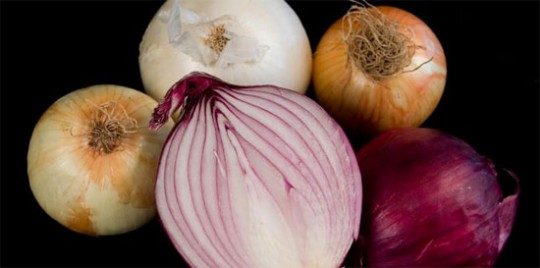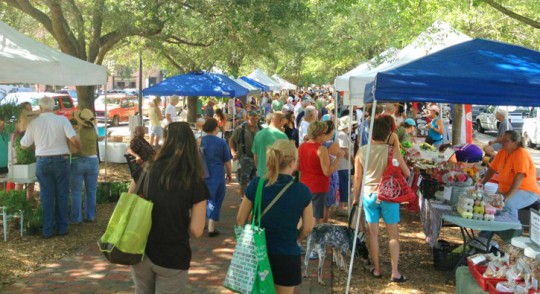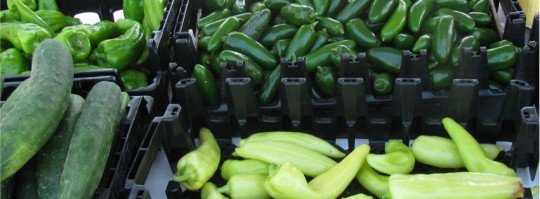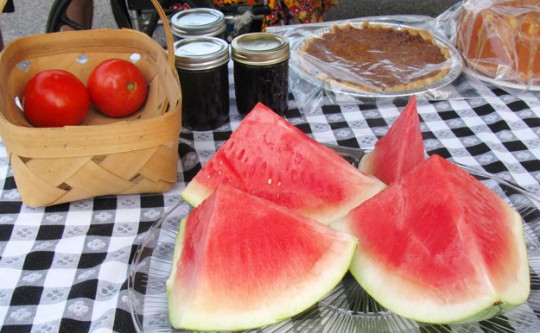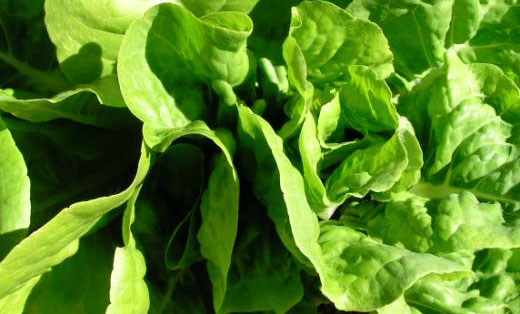Flomaton Honors Area First Responders On 9/11
September 11, 2012
A breakfast Tuesday morning at the Little Escambia Baptist Church in Flomaton remembered 9/11 and honored first responders from Escambia counties in Alabama and Florida.
The Friendship Learning Lodge, a Flomaton preschool, recently made a sign for the nearby Friendship Volunteer Fire Department to thank them and all first responders on 9/11. The was presented to the department today. Submitted photo for NorthEscambia.com, click to enlarge.
Photo Gallery: Northview Cheerleaders, Mini Cheerleaders, Band And Dance Team
September 9, 2012
For a a game summary and action photos, click here.
NorthEscambia.com photos, click to enlarge.
Weekend Gardening: Now’s The Time To Plant Onions
September 9, 2012
Onions are sold in every grocery store, served at many meal and featured at sporting events across the United States. Onions are everywhere. If you’ve ever wanted to try to grow them, now is the time to plant.
Edible onions have been cultivated for so long that it is difficult to trace their origin. Onions were first introduced to America around the turn of the century when a retired French soldier brought some onion seeds from Corsica to the Walla Walla region of the Pacific Northwest. But it wasn’t until the farmers in Georgia realized what a special thing they had in the Vidalia onion and began spreading the news that the sweet onion finally got the attention it deserves.
 Onions have different requirements as to the number of hours of daylight required for bulb formation. The types that require 15 to 16 hours of light daily are referred to as “long day” varieties and not adapted for the South. Types that grow best in Florida are the “short-day” varieties. They must be started in the fall so that bulbing is induced by the short days of winter. However, the subsequent harvest of bulbs follows in the spring or early summer.
Onions have different requirements as to the number of hours of daylight required for bulb formation. The types that require 15 to 16 hours of light daily are referred to as “long day” varieties and not adapted for the South. Types that grow best in Florida are the “short-day” varieties. They must be started in the fall so that bulbing is induced by the short days of winter. However, the subsequent harvest of bulbs follows in the spring or early summer.
Onions are often grouped according to taste (mild and strong flavored), color (white, yellow, and red) and use (storage or freshly eaten). Some suggested bulbing onion varieties for Florida include Excel, Texas Grano, Granex, White Granex and Tropicana Red.
Yellow onions are gardeners’ most popular choices. Granex 33 is the early Texas hybrid grown in Vidalia, Georgia. Texas Grano 1015Y Aggie Sweet produces a large, mild bulb that is very sweet under the right growing and soil conditions. The Texas Grano 502 is well known for large, mild bulbs with fair storage potential.
Onions are grown either from seed, sets (tiny immature bulbs) or transplants. The planting method selected is based on cost, use, availability, and planting ease.
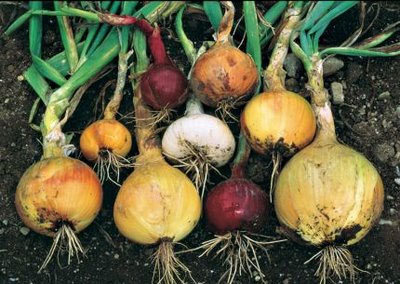 Onions grown from sets do not make the best bulbs, and are rather costly. Specific onion varieties are usually not available. They are sold simply as red, white, or yellow onion sets. Since the variety is unknown, the flavor, use, and keeping quality of onions grown from sets varies considerably. Avoid sets more than an inch in diameter, as they are likely to bolt. Late plantings are more susceptible to cold or freeze injury. Planting too early can result in increased seed stem production.
Onions grown from sets do not make the best bulbs, and are rather costly. Specific onion varieties are usually not available. They are sold simply as red, white, or yellow onion sets. Since the variety is unknown, the flavor, use, and keeping quality of onions grown from sets varies considerably. Avoid sets more than an inch in diameter, as they are likely to bolt. Late plantings are more susceptible to cold or freeze injury. Planting too early can result in increased seed stem production.
Growing onions from seed may be the most difficult planting method. However, it is the least expensive and offers the greatest variety. Germination may be sporadic and plant growth can be slow. Be aware that onion seed does not remain viable long, and should not be planted when more than one year old.
In North Florida, onions can be started between mid-September and mid-November. Onion seed can be planted directly in the garden or in flats. Sow eight to 12 seeds per foot of row ½ to one inch deep. If larger bulbs are desired, thin to a final spacing of four to six inches apart.
Set out transplants from late December through February. Plants should be about 6 inches high and about half the thickness of a lead pencil at the time of transplanting. Set plants with the bottom of the plant about 1 to 1½ inch below the surface of the soil. Transplants should be spaced 3 to 4 inches apart in the row.
Onions have a shallow, poorly developed root system, so regular fertilization and watering are essential. Inconsistent watering may lead to splits, doubles and small bulbs. Fertilize the crop monthly with a nitrogen fertilizer. Be sure to keep the fertilizer from contacting the plants directly.
Good weed control is a must. Since young onions are small and grow slowly at first, they can be taken over by weeds that reduce yield. Look out for diseases before they become established. Leaf blight diseases can seriously reduce yields. Monitor for insects twice each week, and use appropriate management techniques. Contact your local Extension Office for the latest information on pest management recommendations.
Theresa Friday is the Residential Horticulture Extension Agent for Santa Rosa County.
Two Escambia Farmer’s Markets Named Among America’s Favorites
September 7, 2012
Two of the top 10 farmer’s markets in the country are located in Escambia County.
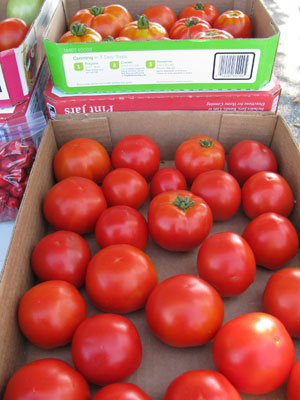 The Market at Saint Monica’s in Cantonment was named the number 10 small market in the country by the group American Farmland Trust. The Palafox Market, held in downtown Pensacola, was named the number 10 large market in the U.S. The Palafox market was also named the Florida’s second favorite.
The Market at Saint Monica’s in Cantonment was named the number 10 small market in the country by the group American Farmland Trust. The Palafox Market, held in downtown Pensacola, was named the number 10 large market in the U.S. The Palafox market was also named the Florida’s second favorite.
The goal of American Farmland Trust’s fourth annual America’s Favorite Farmers Markets contest was to highlight the role that farmers markets play in keeping family farmers on the land. The summer long contest was a nationwide challenge to see which markets can rally the most votes from their customers.
The bi-monthly Market at Saint Monica’s will be open again on September 15.
The Palafox market is open every Saturday from 8 a.m. until 2 p.m. on Palafox Street between Garden and Wright streets in downtown Pensacola.
Pictured top: The Palafox Market in downtown Pensacola. Pictured inset and below: Items for sale earlier this summer at the Market at Saint Monica’s in Cantonment. Courtesy photos for NorthEscambia.com, click to enlarge.
Barrineau Park Community Center To Host Music Night, Swing Dance
September 6, 2012
The Barrineau Park Community Center will play host to two big events Friday and Saturday nights — a bluegrass music night and swing dancing.
Friday — Barrineau Park Music Night
The monthly Barrineau Park Music Night will be held Friday night at the Barrineau Park Community Center. The featured local groups are Southern Sounds and bluegrass group Trugrass.
The singing starts at 6:30 p.m. Food and refreshments will be available beginning at 6 p.m. The event is a family-friendly — no alcohol is permitted on the property, and no smoking is allowed in or near the building.
Admission is free, but donations are accepted for musicians’ expenses.
For more information, call (850) 572-4433. The Barrineau Park Community Center is located on Barrineau Park School road, about three miles west of Molino.
Saturday — Swing Dancing
“Swing Molino Swing”, a family oriented event, will be held at the Barrineau Park Community Center Saturday night.
The event begins at 6:30 p.m. with lessons. There will be a $5 charge to cover costs, and there will be a $5 meal available with a hot dog, chips, dessert and drink. Spike heels are not allowed, and females that plan to wear a dress and practice the dip moves will need a pair of shorts underneath.
Learn More About Starting Your Own Cottage Food Business
September 6, 2012
 Escambia County Extension will host a “Cottage Foods: Starting Your Own Cottage Food Business” program for those that wish to sell food made in their homes.
Escambia County Extension will host a “Cottage Foods: Starting Your Own Cottage Food Business” program for those that wish to sell food made in their homes.
The program will cover pricing, marketing, food safety, demonstrations and include a time for questions and answers with the Extension Service Small Farms and FCS Staff. Farms or individuals interested or currently marketing processed foods are encouraged to attend.
Cottage foods by definition are foods made in the home for resale that do not require refrigeration. These include but are not limited to jams, jellies, preserves, honey, cakes and pies.
The program will be held at 6 p.m. on Tuesday, September 11 at the Escambia County Extension Office at 3740 Stefani Road in Cantonment. The $5 cost of the program will cover materials and handouts. For registration, contact Fran Lainhart at (850) 475-5230 or via email at lainhaf@ufl.edu to register.
Group Claims High School Prayers Illegal; Students Take A Stand
September 5, 2012
The Escambia County (Ala.) School District has banned prayers at events like football games, but that did not stop a group of Flomaton High students from taking a stand on the football field last Friday.
The students stood hand-in-hand along the sidelines before the game in prayer. No faculty or staff took part in the student led, student initiated prayer.
Prayers led over the public address system at Flomaton High School football games was common prior to this year, as was the recital of the Lord’s Prayer by both players and coaches following Hurricane football games.
But that all came to an end prior to Flomaton’s Friday night season opener against Monroeville after the school district received a letter from the Freedom from Religion Foundation that claimed such prayers were illegal.
“A local complainant has reported to us that Flomaton High School has a local pastor, often a Baptist minister, pray before each home football game. This practice is unconstitutional,” FFRF attorney Andrew L. Seidel wrote in a letter to Escambia County (Ala.) School Superintendent Randall Little and Flomaton High Principal Scott Hammond. “It is illegal for a public school to organize, sponsor, and lead prayers at public school events. The Supreme Court has continually struck down formal and teacher or school-led prayer in public schools.”
The Freedom from Religion Foundation is a national nonprofit group with about 19,000 members with the purpose to “protect the constitutional principal of separation between state and church”.
“We ask that Escambia County Public Schools commence an immediate investigation into the complaint alleged, and take immediate action to stop any and all prayers occurring before all Escambia County Public Schools athletic events, including those at Flomaton High School,” Seidel wrote.
The school district responded to the letter by enforcing a ban against facility and students from participating in or leading prayer at school sponsored events.
Get Green Thumb Certified With Master Gardener Training
September 5, 2012
Certifications are available for your hard-earned green thumb – Escambia County Extension is accepting applications through Friday, September 7 for a Master Gardener training class.
Class sessions begin Wednesday, September 26 and continue every Wednesday through November 14, with one Friday class on October 26. Classes resume on Wednesday, January 2 and run continuously through February 6. Normal class hours are 9 a.m. to 1 p.m. The cost for the program is $125 and includes all book and class materials.
Those with a passion for gardening and are interested in serving as a volunteer to assist with community horticulture education programs and activities, are encouraged to apply for training as a Master Gardener. Trainees will complete approximately 60 hours of horticulture training and donate 75 hours of service as an Extension volunteer. Volunteers gain service hours through numerous projects including school and community gardens, community outreach demonstrations, and adult and youth horticulture programs.
For more information, contact Beth Bolles at (850) 475-5230 or email bbolles@uwf.edu with any questions about the program or application process.
For more information, please visit http://escambia.ifas.ufl.edu/hort/master-gardeners.shtml.
Voting Ends Monday: Farmer’s Market In The Running For America’s Favorite
September 2, 2012
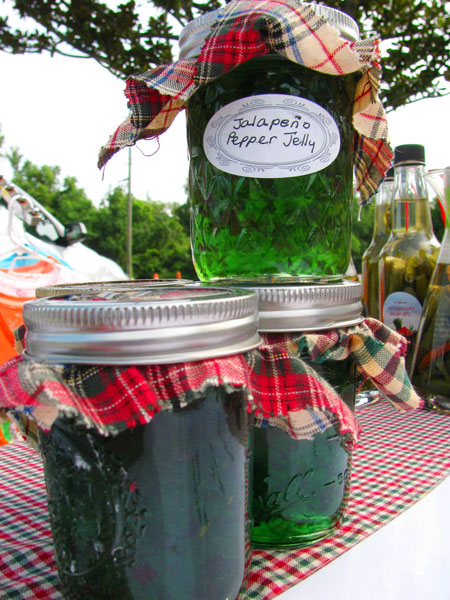 A Cantonment farmer’s market is in the running to be named one of America’s Favorite Farmer’s Markets, and your final chance to vote is Monday.
A Cantonment farmer’s market is in the running to be named one of America’s Favorite Farmer’s Markets, and your final chance to vote is Monday.
The Market at St. Monica’s is one of the contestants in the 2012 competition hosted by the American Farmland Trust. Winners will be featured on the food website Epicurious.com and will be honored at local celebrations with a prize package.
Market shoppers can cast their vote in support of their region’s farmers, community and market. To vote for The Market at St. Monica’s, click here and select the market. After voting, American Farmland Trust will solicit a donation to protect American farmland, but donations are not required to vote.
The Market at St. Monica’s is open on the first and third Saturdays of each month from 8 a.m. until noon with a variety of locally grown produce and other merchandise at St. Monica’s Episcopal Church at 699 County Road 95-A South in Cantonment.
The market will be open again September 15.
Pictured: Scenes from a recent Market at St. Monica’s. Submitted photos for NorthEscambia.com, click to enlarge.
Gardening: Fall Veggies Are Cool To Grow In North Escambia Area
September 2, 2012
In Northwest Florida, vegetable lovers can enjoy harvests from their backyard gardens throughout the year. However, to ensure a productive and enjoyable vegetable garden, you must understand and abide by planting times.
 In general, vegetable crops can be grouped into warm-season and cool-season varieties. Warm-season crops do not grow well at temperatures below 50 degrees F and are killed by frost. Cool-season crops are those that grow at lower temperatures, are not injured by light frost, but can’t take the heat.
In general, vegetable crops can be grouped into warm-season and cool-season varieties. Warm-season crops do not grow well at temperatures below 50 degrees F and are killed by frost. Cool-season crops are those that grow at lower temperatures, are not injured by light frost, but can’t take the heat.
In late summer and early fall, North Florida gardeners experience a unique opportunity. You can still plant another round of warm-season crops and/or start your cool-season vegetables.
Planting of warm-season vegetables gets to be more critical with the fall garden because we have an end point—frost and freezes. When planted too late, plants will grow, but may not provide enough of a harvest to make the effort worthwhile. Examples are peppers, eggplants and tomatoes. These vegetables can easily take up to two months from transplanting to producing the first fruit. All the time, the fall is getting shorter in day length and cooler in temperatures. That’s really tough on “warm-loving,” full-sun plants.
Since timing is so important with the fall crop, choose warm-season crops that will produce well within a short time. Look for fast-maturing and determinant or bush-type cultivars to ensure a good yield before frost.
Crops to plant outdoors in August include bush and lima beans, cauliflower, collards, cucumbers, onions, southern peas, peppers, squash, tomato and turnips.
In September, you can set out beets, broccoli, cabbage, carrots, endive, kale, kohlrabi, mustard and radish.
The cooler temperatures of October are better for planting Chinese cabbage, lettuce and spinach.
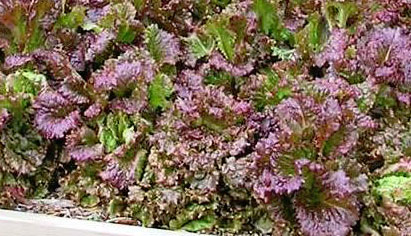 To find specific recommendations on when to plant vegetables in Florida, read the UF/IFAS “Vegetable Gardening Guide”. It’s online at edis.ifas.ufl.edu/vh021
To find specific recommendations on when to plant vegetables in Florida, read the UF/IFAS “Vegetable Gardening Guide”. It’s online at edis.ifas.ufl.edu/vh021
The leafy crops excel in the fall. Some of the more popular leafy crops are Swiss chard, collards, spinach, mustard, turnip greens and lettuce. Endive, escarole, kale, arugula and the greens of mesclun mix also do very well during the cooler months.
Garden lettuces can be divided into three classes based on habit of growth – leaf or loose-leaf types, semi-heading types (such as butterhead and romaine) and heading or crisp-head types.
Crisp-head lettuces, such as the iceberg types available in supermarkets, are more of a challenge to grow here, so its recommend you stay with the leaf and semi-heading varieties. Other than generally avoiding the heading types, feel free to try just about any variety that strikes your fancy.
Leaf lettuces are the most decorative and least-demanding. They also are among the most heat-tolerant lettuces. This type of lettuce grows in a loose rosette of foliage, and the leaves can be smooth or crinkled, pointed, lobed, curled or ruffled. Foliage color runs from deep ruby red to dark green to pale greenish yellow, with just about every combination in between.
Collards will withstand wide ranges of temperatures if properly conditioned. They may be direct seeded and or plants can be transplanted. Collards may be harvested by cutting the whole plant or by “cropping” individual leaves.
Onions are generally grown from sets or plants. Sets and plants will require about six to eight weeks to reach eating size. Bulbing onions will not be ready to harvest until spring.
Radishes are fast growers and fun for the kids. Many are ready to harvest 25 to 30 days after planting.
So take the leap and “fall” into vegetable gardening.
Theresa Friday is the Residential Horticulture Extension Agent for Santa Rosa County





